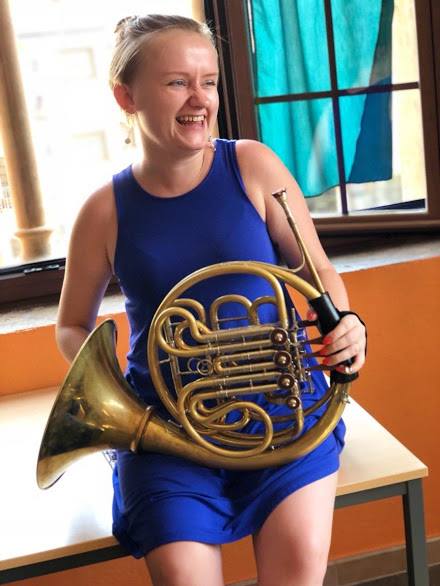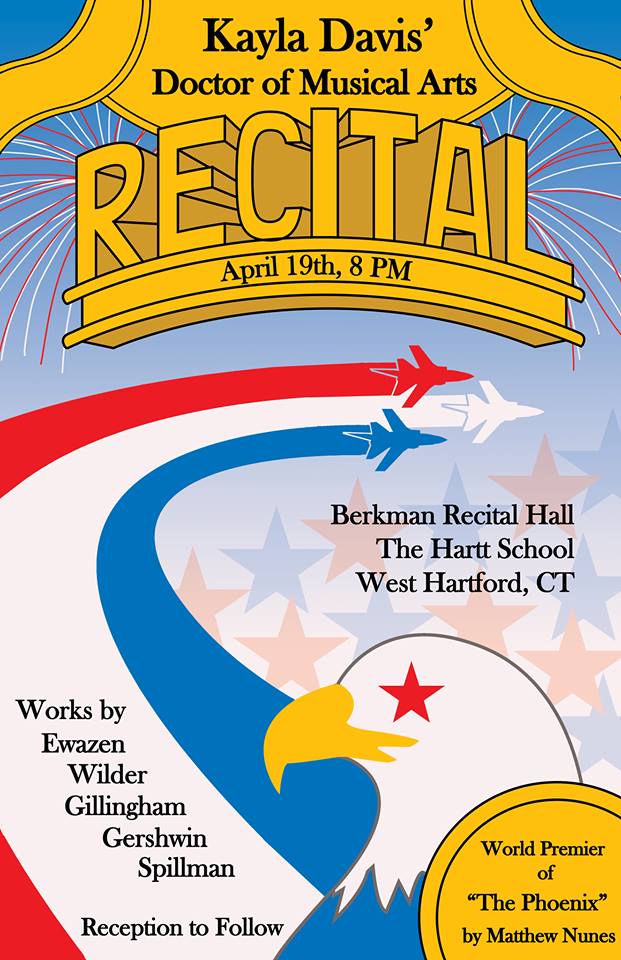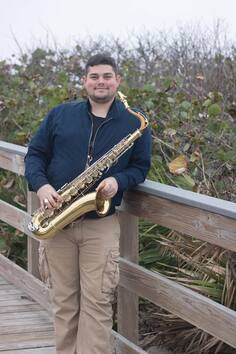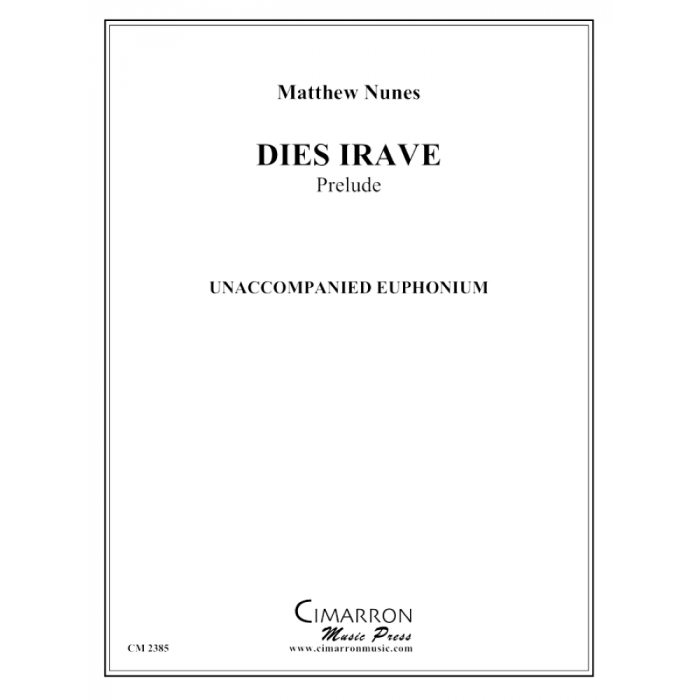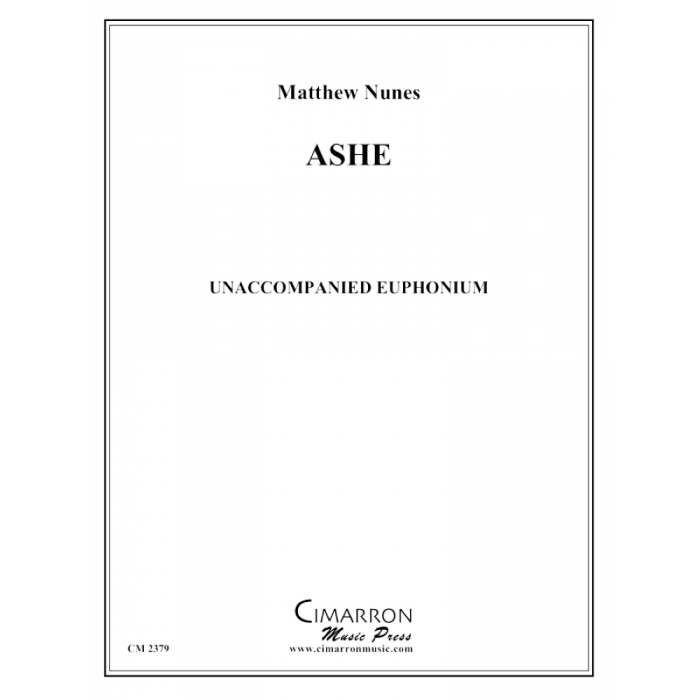This is a CHRONOLOGICAL list of my works for SOLOS. For larger-medium Concerti please see the LARGE ENSEMBLE page.
Solos
Song without words for Euphonium and Piano (2018)
Click here to purchase
A symphony, snared in just a name.
An opera, to end with bursts of flame.
A ballet, that leapt from her tongue and dances in my ear.
A requiem, for you are not here.
- August 24th, 2018
Niceville, Florida
Click here to purchase
A symphony, snared in just a name.
An opera, to end with bursts of flame.
A ballet, that leapt from her tongue and dances in my ear.
A requiem, for you are not here.
- August 24th, 2018
Niceville, Florida
|
Concerto for Karu (Concerto for Horn and Piano) (2018)
For Rebecca Karu I. Allegro – “Becky K” II. Elegy – “for you” III. Tarantella – “BB” Concerto for Karu (Concerto for Horn and Piano) is written for one of my best buddies, Rebecca Karu, who I met during my time at Montclair State University. The concerto is in three distinct movements that feature a look into our friendship. The themes of the first movement are energetic musical representations of Rebecca’s name while the development shows off her skill. The second movement reflects our final weeks together and the insecurities of the future are represented in stark contrasts to the gentle melody. The finale, a rampant tarantella, features multiple layers of musical mirroring revolving around written B-flat’s/B’s and concert B-flat’s/B’s in a dazzling rush to the finish. Happy 21st Birthday!!! - Matthew Nunes Montclair, New Jersey and Windsor, Connecticut November 22nd, 2017 – January 25th, 2018 |
Where Are You? for Voice and Piano (2016)
Click here to purchase
Where Are You? is my second work for voice and piano. It belongs in the same song cycle as Eclipse and was originally conceived from a male’s perspective. Despite this, it works equally as well for either gender and the range is from G#3 to B5. I wrote both the music and lyrics in one day and am very satisfied with the end result. Enjoy!
- Matthew Nunes
October 16th, Montclair, New Jersey
Click here to purchase
Where Are You? is my second work for voice and piano. It belongs in the same song cycle as Eclipse and was originally conceived from a male’s perspective. Despite this, it works equally as well for either gender and the range is from G#3 to B5. I wrote both the music and lyrics in one day and am very satisfied with the end result. Enjoy!
- Matthew Nunes
October 16th, Montclair, New Jersey
Hebdomad for Piano (2016)
Click here to purchase
Hebdomad is a piano suite where each movement reflects a day in the week. The order is to be determined by the performer. There are 5,040 possible ways to order these movements - the current numerical designations are arbitrary.
- Matthew Nunes
Orlando, Florida
Click here to purchase
Hebdomad is a piano suite where each movement reflects a day in the week. The order is to be determined by the performer. There are 5,040 possible ways to order these movements - the current numerical designations are arbitrary.
- Matthew Nunes
Orlando, Florida
Concerto for Flute and Flute Choir (2016)
Commissioned by Dr. Nora Lee Garcia
I have been very fortunate to be surrounded by some of the world’s top performers. One such example is Dr. Nora Lee Garcia who is the flute instructor at the University of Central Florida. Her skills, and the skills of her students, impressed me as a composer during my time there. Her expertise and assistance in the premiere of Flurry for Flute Quartet (or ensemble) changed the way I approached writing for the instrument. In the summer of 2015 she commissioned this work for soloist and flute choir.
The Concerto for Flute and Flute Choir takes its material from assigning pitches to each letter of the performer’s name (similar to my euphonium concerto). The opening movement – Tocar – is a toccata presenting a theme and virtuosic variations. It touches base on all the tones assigned in this work but focuses on those assigned to “Nora”. The chromatic second movement – Claro – represents a person clearing away the surface of their soul in search of something deeper. “Lee” is focus of this movement. The finale movement – Vuelo – is a dazzling finale in rondo form making use of the remaining pitches.
It has been a fun work to compose and one that has pushed my creativity and technique.
- Matthew Nunes
Windsor, 2016
Commissioned by Dr. Nora Lee Garcia
I have been very fortunate to be surrounded by some of the world’s top performers. One such example is Dr. Nora Lee Garcia who is the flute instructor at the University of Central Florida. Her skills, and the skills of her students, impressed me as a composer during my time there. Her expertise and assistance in the premiere of Flurry for Flute Quartet (or ensemble) changed the way I approached writing for the instrument. In the summer of 2015 she commissioned this work for soloist and flute choir.
The Concerto for Flute and Flute Choir takes its material from assigning pitches to each letter of the performer’s name (similar to my euphonium concerto). The opening movement – Tocar – is a toccata presenting a theme and virtuosic variations. It touches base on all the tones assigned in this work but focuses on those assigned to “Nora”. The chromatic second movement – Claro – represents a person clearing away the surface of their soul in search of something deeper. “Lee” is focus of this movement. The finale movement – Vuelo – is a dazzling finale in rondo form making use of the remaining pitches.
It has been a fun work to compose and one that has pushed my creativity and technique.
- Matthew Nunes
Windsor, 2016
Horizon for Trumpet and Two Percussionists (2016)
“Lost time is never found again; and what we call time enough, always proves little enough”
- Benjamin Franklin
Horizon is conceived as attempting to escape from the black hole that is depression. Light cannot escape the gravity of a black hole much like it seems impossible to escape such a state of mind. The quote from Benjamin Franklin is not only a huge hint to the framework of the piece it is a reflection on what we lose when we dwell on the past.
The work is based on a motif from a work I performed in the brass band. The opening four notes are from Edward Gregson’s Symphony in Two Movements and are a set of notes he’s used frequently throughout his career – E-natural, F-natural, A-flat, and C-natural. In an interview with Dr. Stephen Allen he called this motif a “cry for help” in the context of Symphony.
The piece is in three large sections with each of these containing three sections. Motives
in these sections change with time-points patterns. Each section revolves around a certain pitch in the main motif.
The middle section is what I call the “singularity”. It is a dream-like section with the solo
part growing more hopeful – the upward inflection of the “cry for help” is imitated with more consonant tones. Instrumentation changes to create this weightless aura and there is an emphasis on exposed, solo playing.
Listeners will notice that the first large section and the last reflect each other – the only difference is that the inner sections are influenced by an alternate time-point. The trumpet changes from being subservient to its surroundings to charging through it. The work ends with the trumpet broadening out the key tones as if in relaxation. However, the final bars hint that what has ended may only be beginning again…
- Matthew Nunes
Windsor, March 11th, 2016
“Lost time is never found again; and what we call time enough, always proves little enough”
- Benjamin Franklin
Horizon is conceived as attempting to escape from the black hole that is depression. Light cannot escape the gravity of a black hole much like it seems impossible to escape such a state of mind. The quote from Benjamin Franklin is not only a huge hint to the framework of the piece it is a reflection on what we lose when we dwell on the past.
The work is based on a motif from a work I performed in the brass band. The opening four notes are from Edward Gregson’s Symphony in Two Movements and are a set of notes he’s used frequently throughout his career – E-natural, F-natural, A-flat, and C-natural. In an interview with Dr. Stephen Allen he called this motif a “cry for help” in the context of Symphony.
The piece is in three large sections with each of these containing three sections. Motives
in these sections change with time-points patterns. Each section revolves around a certain pitch in the main motif.
The middle section is what I call the “singularity”. It is a dream-like section with the solo
part growing more hopeful – the upward inflection of the “cry for help” is imitated with more consonant tones. Instrumentation changes to create this weightless aura and there is an emphasis on exposed, solo playing.
Listeners will notice that the first large section and the last reflect each other – the only difference is that the inner sections are influenced by an alternate time-point. The trumpet changes from being subservient to its surroundings to charging through it. The work ends with the trumpet broadening out the key tones as if in relaxation. However, the final bars hint that what has ended may only be beginning again…
- Matthew Nunes
Windsor, March 11th, 2016
Concerto for Euphonium and Tuba-Euphonium Quartet (2015)
Click here to purchase
In May of 2015 I completed the Concerto for Euphonium and Wind Band for one of my former teachers. Soon after I began realizing that concerti written with tuba-euphonium quartet as the supporting ensemble were extremely rare (and possibly non-existent). Ideal for soloists visiting schools with resident quartets this piece is an attempt to fill a gap in the literature. It is also ideal for larger ensembles.
Each movement is connected by manipulations of the motive F, A-flat, and B-flat. Of the plethora of options the relationships between these notes presented I used the minor third and the upper or lower neighbor tones the most frequently, whether it be hidden inside the themes or outlining the work’s largest structures.
- Matthew Nunes
Windsor, September 2015
Click here to purchase
In May of 2015 I completed the Concerto for Euphonium and Wind Band for one of my former teachers. Soon after I began realizing that concerti written with tuba-euphonium quartet as the supporting ensemble were extremely rare (and possibly non-existent). Ideal for soloists visiting schools with resident quartets this piece is an attempt to fill a gap in the literature. It is also ideal for larger ensembles.
Each movement is connected by manipulations of the motive F, A-flat, and B-flat. Of the plethora of options the relationships between these notes presented I used the minor third and the upper or lower neighbor tones the most frequently, whether it be hidden inside the themes or outlining the work’s largest structures.
- Matthew Nunes
Windsor, September 2015
|
The Phoenix for Tuba and Piano (2015)
Commissioned by Kayla Davis Premiered April 19th by Kayla Davis (tuba) and Elisabeth Tomczyk (piano) Click here to purchase The Phoenix is a tour de force piece for tuba and piano commissioned by Kayla Davis. The piece represents the internal and external struggles associated with challenging a mindset that desperately needs repair but refuses to listen. Daunting chords signify a near-impossible foe while the tuba represents a lone phoenix fighting for change. Inevitably the phoenix is wounded and nears defeat. It is in this time that the slightest glimmer of hope gives way to rebirth – a stronger and wiser version of the phoenix charges forth, refusing to yield. The work ends triumphantly but whether the battle has been won or our phoenix has escaped to see another day is up to the listener to discern. The material of this work is derived from a seven-note motive created by assigning each letter in the word “phoenix” to a pitch. There are also several references to composers and works Kayla and I were performing during the piece’s inception. Some references are harmonic or rhythmic, some are structural, and others cry out at the frustrations associated with daily life in a place where the mindset needs challenging. - Matthew Nunes West Hartford, Connecticut February 2015 |
Au Contraire! for Contrabassoon (or Bassoon) (2014)
For Kristen Lichtenthal
Click here to purchase
As a composer who plays the euphonium I often find that my peers and I are victims of the misconception that bass instruments are not capable of agility, grace, or, in some cases, musicality. Au contraire! While the standard is to teach bass instruments to support the “more able” ones we are more than capable.I was finally given the exigency to write a work disproving these thoughts when contrabassoon enthusiast Kristen Lichtenthal said I should write a work for her instrument. This work has two basic ideas: the first is to display the virtuosity capable of a contrabassoon, the second is to offer a light-hearted touch to an instrument typically brought in for more serious-natured works.
Although this work was originally intended for contrabassoon I have no qualms about it being performed on bassoon.
- Matthew Nunes
Orlando, April 2014
For Kristen Lichtenthal
Click here to purchase
As a composer who plays the euphonium I often find that my peers and I are victims of the misconception that bass instruments are not capable of agility, grace, or, in some cases, musicality. Au contraire! While the standard is to teach bass instruments to support the “more able” ones we are more than capable.I was finally given the exigency to write a work disproving these thoughts when contrabassoon enthusiast Kristen Lichtenthal said I should write a work for her instrument. This work has two basic ideas: the first is to display the virtuosity capable of a contrabassoon, the second is to offer a light-hearted touch to an instrument typically brought in for more serious-natured works.
Although this work was originally intended for contrabassoon I have no qualms about it being performed on bassoon.
- Matthew Nunes
Orlando, April 2014
|
Constance for Baritone Saxophone and Piano (2013)
Commissioned by Nicholas Kevin Phillips Premiered April 5th, 2014 by Nicholas Kevin Phillips (baritone saxophone) and Gregory Monroe, II (piano) Published by Cimarron Music Press Constance is a piece especially composed for Nicholas Kevin Phillips, a saxophone player I met at the University of Central Florida, as a personal thank you for his generous donation to my “Get Matt to Maryland” Rally via rally.org. The inspiration of this work is the constant drive required to get where we want our lives to go. This is represented by the striving baritone saxophone melody. It evolves slowly, reflectively, aiming for the heights – a celebration of success and joy. The celebration is short-lived. We realize we have not yet arrived and that we are farther away than we initially thought… - Matthew Nunes, June 27th, 2013 |
|
Dies Irave for Unaccompanied Euphonium (2013)
Premiered June 2014 by Matthew Nunes Published by Cimmarron Music Press In musical history dozens of composers have borrowed snippets of the Dies Irae, or Day of Wrath Gregorian chant. This chant, c. 1200 – 1300 AD, depicts the judgment day where God saves the worthy individuals and leaves the unworthy behind to perish in eternal flames. I use this chant in a way, not to evoke pain and suffering, but in irony that no matter what we do we are stuck in the flow of time and must submit to nature’s rhythm. - Matthew Nunes, August 2013 |
|
Ashe for Unaccompanied Euphonium (2013)
Commissioned by Ashley Klumpp Premiered Fall 2013 by Ashley Klumpp (euphonium) Published by Cimmarron Music Press Ashe is a piece especially composed for Ashley Klumpp, a euphonium player I met at the University of Central Florida, as a personal thank you for her generous donation to my “Get Matt to Maryland” Rally via rally.org. The basis for this work is inspired by Robert Schumann’s piano piece Carnaval (1834) and a technique he used to compose it. Schumann’s piece features pitches that spell out names of a town, a friend, and a lover as the melodic basis for each movement. With Ashe I used four letters from Ashley’s name that serve as the melodic pitches and are frequently used throughout: A = A-natural; S = Es, or E-flat; H = B-natural*; and E = E-natural. *(in this piece I substitute B-natural with Bb) I also imagined an innocent person, represented by the mid to high register, being closely hunted by a menacing creature, lurking in the bowels of the euphonium range. These two forces are destined to collide, and which one prevails is up to the listener to decide. - Matthew Nunes, May 2013 |
Raeswain for Unaccompanied Flute (2013)
Commissioned by Danielle Giguere
Click here to purchase
Ræswian is an Anglo-Saxon word meaning to deeply ponder and analyze a subject through various viewpoints. I have known Danielle for a few years now and the dynamic of our relationship has altered over time. For the primary material of this work I used the first three notes of a melody I composed for her a few years earlier. I freely work through this material in an old folk-song like manner to explore how differently its intervallic patterns can be perceived. It is a work that I hope evokes one to analyze all possibilities before making an assumption.
Commissioned by Danielle Giguere
Click here to purchase
Ræswian is an Anglo-Saxon word meaning to deeply ponder and analyze a subject through various viewpoints. I have known Danielle for a few years now and the dynamic of our relationship has altered over time. For the primary material of this work I used the first three notes of a melody I composed for her a few years earlier. I freely work through this material in an old folk-song like manner to explore how differently its intervallic patterns can be perceived. It is a work that I hope evokes one to analyze all possibilities before making an assumption.
Eclipse for Mezzo-Soprano and Piano (2011)
Premiered November 14th, 2011 by Amber Farish (mezzo-soprano) and Brandon Clinton (piano)
Click here to purchase
Eclipse is a work for mezzo-soprano and piano written during the inception of a song cycle. This work is meant to be sung by a woman who has removed herself from involvement in any more romantic relationships. This piece reveals why, as she bore witness to the acts of an unfaithful lover. Haunted by these memories she taps into a well of unresolved bitterness that consumes her and she is unable to suppress her pain.
The lyrics were written in 2010 and the music was completed the following year. It was my pleasure to work with Amber Farish (Mezzo-Soprano) and Brandon Clinton (Piano) for the premiere of this piece on November 14th, 2011 in Orlando, Florida.
- Matthew Nunes
Niceville, Florida
Premiered November 14th, 2011 by Amber Farish (mezzo-soprano) and Brandon Clinton (piano)
Click here to purchase
Eclipse is a work for mezzo-soprano and piano written during the inception of a song cycle. This work is meant to be sung by a woman who has removed herself from involvement in any more romantic relationships. This piece reveals why, as she bore witness to the acts of an unfaithful lover. Haunted by these memories she taps into a well of unresolved bitterness that consumes her and she is unable to suppress her pain.
The lyrics were written in 2010 and the music was completed the following year. It was my pleasure to work with Amber Farish (Mezzo-Soprano) and Brandon Clinton (Piano) for the premiere of this piece on November 14th, 2011 in Orlando, Florida.
- Matthew Nunes
Niceville, Florida
